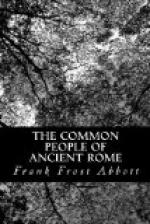as we are in finding out whether the Roman or the
American workman could buy more of these commodities
with the returns for his labor. A starting point
for such an estimate is furnished by the Eighteenth
Annual Report of the Commissioner of Labor, on the
“Cost of Living and Retail Prices of Food”
(1903), and by Bulletin No. 77 of the Bureau of Labor
(1908). In the first of these documents (pp. 582,
583) the expenditure for rent, fuel, food, and other
necessities of life in 11,156 normal American families
whose incomes range from $200 to $1,200 per year is
given. In the other report (p. 344
f.)
similar statistics are given for 1,944 English urban
families. In the first case the average amount
spent per year was $617, of which $266, or a little
less than a half of the entire income, was used in
the purchase of food. The statistics for England
show a somewhat larger relative amount spent for food.
Almost exactly one-third of this expenditure for the
normal American family was for meat and fish.[94]
Now, if we take the wages of the Roman carpenter,
for instance, as 21 cents per day, and add one-fourth
or one-third for his “keep,” those of
the same American workman as $2.50 to $4.00, it is
clear that the former received only a ninth or a fifteenth
as much as the latter, while the average price of
pork, beef, mutton, and ham (7.3 cents) in 301 A.D.
was about a third of the average (19.6 cents) of the
same articles to-day. The relative averages of
wheat, rye, and barley make a still worse showing
for ancient times while fresh fish was nearly as high
in Diocletian’s time as it is in our own day.
The ancient and modern prices of butter and eggs stand
at the ratio of one to three and one to six respectively.
For the urban workman, then, in the fourth century,
conditions of life must have been almost intolerable,
and it is hard to understand how he managed to keep
soul and body together, when almost all the nutritious
articles of food were beyond his means. The taste
of meat, fish, butter, and eggs must have been almost
unknown to him, and probably even the coarse bread
and vegetables on which he lived were limited in amount.
The peasant proprietor who could raise his own cattle
and grain would not find the burden so hard to bear.
Only one question remains for us to answer. Did
Diocletian succeed in his bold attempt to reduce the
cost of living? Fortunately the answer is given
us by Lactantius in the book which he wrote in 313-314
A.D., “On the Deaths of Those Who Persecuted
(the Christians).” The title of Lactantius’s
work would not lead us to expect a very sympathetic
treatment of Diocletian, the arch-persecutor, but
his account of the actual outcome of the incident
is hardly open to question. In Chapter VII of
his treatise, after setting forth the iniquities of
the Emperor in constantly imposing new burdens on
the people, he writes: “And when he had
brought on a state of exceeding high prices by his
different acts of injustice, he tried to fix by law




